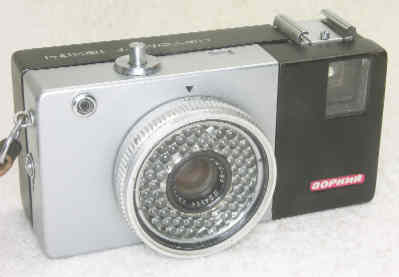

KMZ Zorki 12
The largest Soviet camera company, KMZ, made a very successful line of 35mm
cameras -- the Zorki's. These were full-frame 35mm cameras and were
initially designed like the original Leica 35mm. But each Zorki model
improved on the previous model in one way or another -- just like the Leicas.
The Zorki 10, however, was a completely different style, and very similar
to the Ricoh Auto 35. It was very popular, of course, and over 1/3
of a million were manufacturered.
The Zorki 12 appeared in 1967 and was the last of the Zorki series, but it was not just a modification of the Zorki 11 -- and it was nothing like a Leica or a Ricoh. It was a whole redesign in many ways, but most importantly, the Zorki 12 is a half-frame camera -- unlike all of its full-frame predecessors. It had a focusing 28mm (f2.8) lens, close-focusing to 0.8 meters (2.5 feet). It is marked in meters but also has symbols for scenic, group, and portrait shots. The lens has f-stops from f2.8 to f16 which can be set manual or automatically. The shutter has speeds of 1/30 - 1/250. These are set by the film speed -- the higher the film speed, the higher the shutter speed. The built-in selenium meter around the lens sets the aperture after the shutter speed is selected (by dialing in the film speed). It uses a system very similar to the Agfa Rapid cassette design, but uses KMZ cassettes which are nearly identical, except that they are plastic and lack the film speed tab of the Agfa version. The film speed is manually selected by turning a small dial inside the camera -- with a small read-out window on the back -- from 16 to 250. There is a small film speed conversion table inside the film door. For normal use, the camera is set to "AUTO" -- an "A" in a small window on the side of the camera, but the f-stop can be selected manually for flash use in the same window (the shutter speed is set to 1/30) -- just like most of the cameras that used the Agfa Rapid cassettes. The camera has a film counter and cold flash shoe on the top, and a PC connection on the front. It also has a tripod socket on the bottom, but no cable release connection. Since one half of the camera is black and the other half chrome, it looks like the camera is somehow snapped together, but the film is inserted through a typical door. It is not marked as KMZ or Zorki 12, and because it is marked "ABTOMAT" on the top, it is sometimes called the AUTOMAT. Only about 7,000 cameras were produced, probably because the KMZ film cassettes were very difficult to obtain in Russia at the time -- so the Zorki 12 is very difficult to find.
On to of that, there are at least four variations of the camera, but some or most of these might have been prototypes. For example, one variant has a lug on both ends of the camera instead of just one, another has "ZORKI 12" on the front in Cyrillic, one has the PC connection on the top plate instead of the front plate, and there were a few different 28mm lenses used on the cameras -- making for a collector's paradise, I suppose!